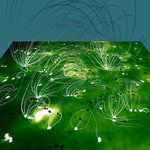Physics

Using measurements of the four ESA's Cluster satellites, a study published this week in Nature Physics shows pioneering experimental evidence of magnetic reconnection also in turbulent 'plasma' around Earth.
This image provides a model of magnetic fields at the Sun's surface using SOHO data, showing irregular magnetic fields (the ‘magnetic carpet’) in the solar corona (top layer of the Sun's atmosphere). Small-scale current sheets are likely to form in such turbulent environment and reconnection may occur in similar fashion as in Earth's magnetosheath. Credits: Stanford-Lockheed Inst. for…
Nanomechanical oscillators -- tiny strips of vibrating silicon only a few hundred atoms thick -- are the subject of extensive study by nanotechnology researchers. They could someday replace bulky quartz crystals in electronic circuits or be used to detect and identify bacteria and viruses.
The catch is that measuring their vibrations isn't easy. It is usually done by bouncing laser beams off them -- which won't work when the nanodevices become smaller than the wavelength of the light -- or with piezoelectric devices -- those bulky quartz crystals we're trying to get rid of.
Schematic of…

Researchers in Japan have developed a pair of molecular-scale scissors that open and close in response to light. The tiny scissors are the first example of a molecular machine capable of mechanically manipulating molecules by using light, the scientists say.
The scissors measure just three nanometers in length, small enough to deliver drugs into cells or manipulate genes and other biological molecules, says principal investigator Takuzo Aida, Ph.D., professor of chemistry and biotechnology at the University of Tokyo.
The scissors-like molecular machine extends or folds in response to…

As an electromagnetics guy I stay in touch with a lot of what is happening in that segment of physics by subscribing to plain, ol' email lists. People who need info just fire off a question to the group and someone helps.
Occasionally recruiters spam the place because, you know, all of their recruiting emails are terribly important to the whole planet. When I got my email this morning, I saw this:
To: si-list@freelists.org
Subject: [SI-LIST] Google: Hiring SI Engineers, Mountain View, CA
Reply-To: nmalone@google.com
Google's Platforms group is looking for SI Engineers. Platforms has
many…

University of Chicago scientists will demonstrate how to incinerate a white dwarf star in unprecedented detail at the “Paths to Exploding Stars” conference on Thursday, March 22, in Santa Barbara, Calif.
White dwarf stars pack one and a half times the mass of the sun into an object the size of Earth. When they burn out, the ensuing explosion produces a type of supernova that astrophysicists believe manufactures most of the iron in the universe. But these type Ia supernovas, as they are called, may also help illuminate the mystery of dark energy, an unknown force that dominates the universe…
A new nanoscale apparatus developed at JILA—a tiny gold beam whose 40 million vibrations per second are measured by hopping electrons—offers the potential for a 500-fold increase in the speed of scanning tunneling microscopes (STM), perhaps paving the way for scientists to watch atoms vibrate in high definition in real time.
This slow-motion simulation of the JILA nanoscale motion detector shows the wiggling of a floppy metal beam, just 100 nanometers thick, as it is struck by an electric current at the dot. Red indicates the greatest change in position from the rest state. Credit: Credit…

Despite advances in experimental nuclear physics, the most detailed probing of atomic nuclei still requires heavy doses of advanced nuclear theory. The problem is that using theory to make meaningful predictions requires massive datasets that tax even high-powered supercomputers.
In a March 16 Physical Review Letters article, researchers from Michigan State and Central Michigan universities report dramatic success in stripping away much of this stubborn complexity. The advance, which slashes computational time from days or weeks to minutes or hours, may help address one of the most…
For the first time, scientists of the BaBar experiment at the Department of Energy's Stanford Linear Accelerator Center (SLAC) have observed the transition of one type of particle, the neutral D-meson, into its antimatter particle. This observation will now be used as a test of the Standard Model, the current theory that best describes all the universe's luminous matter and its associated forces.
Silicon Vertex Tracker. The SVT is the heart of the BABAR experiment at SLAC—in the photo, physicists are putting the finishing touches on improvements to the detector. (Photo Courtesy of Peter…

Work completed by a visiting research professor at Rowan University, physics professors and a student from the institution shows that light is made of particles and waves, a finding that refutes a common belief held for about 80 years.
Shahriar S. Afshar, the visiting professor who is currently at Boston's Institute for Radiation-Induced Mass Studies (IRIMS), led a team, including Rowan physics professors Drs. Eduardo Flores and Ernst Knoesel and student Keith McDonald, that proved Afshar’s original claims, which were based on a series of experiments he had conducted several years ago.
An…

Quantum gravity is the holy grail of theoretical physics in the 21st century. The frustrating thing about the search for it is that the window in which we could experimentally access quantum effects of gravity is very far away from what we can reach. It would take particle energies as high as 1016 TeV to access them. That is 15 orders of magnitude higher than what even the Large Hadron Collider - The World's largest Microscope - will probe. Alternatively, one had to examine distances as small as 10-20femtometers!
Nevertheless, the situation is not completely hopeless, and over…